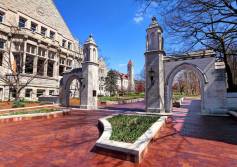Health data will guide University of Arizona’s campus reopening

In-person classes at the University of Arizona will resume for the fall semester, but the plan to bring students back to campus will be informed by health data and adapted to changing public health conditions so students and faculty are kept safe, university leaders told EdScoop.
The University of Arizona plans to begin the school year next week with a limited number of students on campus and slowly increase its campus population over the coming weeks, said Richard Carmona, director of UA’s campus reentry task force. But the unpredictable nature of the pandemic means that the university has to be prepared to make swift changes to its plans for the fall semester, he said, based off public health conditions at the county, state and national level.
The advisory team will collect data on how many students and faculty are on campus, the number of beds available to quarantine sick students, how many respirators the university hospital has available and any confirmed or potential COVID-19 cases on campus, said Carmona, who served as surgeon general under President George W. Bush. They’ll also collect data from the surrounding community, on staffing levels at local hospitals, health regulations put out out by the county and any positive cases in the county — “so we can get an idea of the scope and the scale of what we have to deal with,” he said.
Data will be presented to university President Robert Robbins on a daily basis, Carmona said, so he can make informed decisions.
The university has also implemented a contact tracing system to alert students who may have been exposed to the virus to further limit potential transmission. Other universities, including the University of California, San Diego, Purdue University and Oklahoma State University, have implemented similar technologies to track the the spread of COVID-19 and collect health data from students and faculty.
Currently, the University of Arizona plans to bring about 5,000 students back to campus for the beginning of the fall semester on Aug. 24. This first cohort of students will enroll in in-person classes, such as research labs, medical courses, and fine arts and performing arts studios, which don’t adapt to the remote learning environment as well because of their reliance on specialized equipment.
After that, in-person of up to 30 people will begin meeting, bringing an estimated 14,000 people to campus, and eventually, larger courses will resume on campus, with about half of all courses having some in-person component. At that point, between 25,000 and 30,000 people will be on campus, Carmona said, which is less than half the number on campus during a regular semester.
However, the speed with which the campus will reopen will be entirely dependent on the health conditions of the campus and local community, he said, as well as the resources the university has available, like the number of rooms available in campus isolation dorms for students who have potentially contracted the virus and hospital resources to treat any sick faculty or students.
And should changing conditions put the health of students and faculty at risk, Carmona said, the university will shut down and move all classes back to a fully online format.
“At any time we see any of the metrics that are going in the wrong direction, we can stop,” he said.
To mitigate the possibility of transmitting the disease, students and faculty will be required to follow social distancing guidelines, wear masks on campus at all times and go in for regular COVID-19 testing. Students are also being asked not to engage in risky behavior like attending off-campus parties.
Bringing students back to campus poses some risk, Carmona said, “but for the privilege of being on campus, we’re educating and asking that the students will adhere to these new policies.”
The data the university collects on health conditions of the campus and surrounding community will also be shared with students to make them aware of changing circumstances and to stress the importance of following university guidelines.
Carmona emphasized that the university will adjust its plans to reopen quickly should public health conditions worsen or if there is failure among the campus community to follow health guidelines set out by the university.
“As the science evolves, we continue to adapt to the new knowledge we’re getting,” he said. “It’s not that we’re changing our minds randomly. The science evolves so rapidly that we continue to have to adjust policies. … This is brand new to the whole world and we’re learning as we move forward.”




